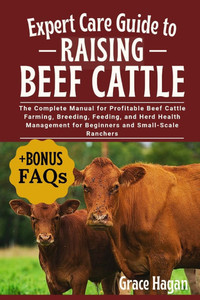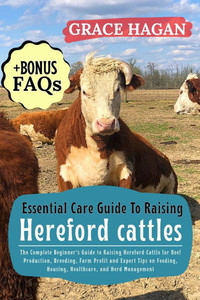
Angus Cattles Care and Ownership: The Complete Guide To Raising Angus Cattle For Beef, Breeding, Profitable Farming And Expert Advice On Feeding, Hous
Independently published
ISBN13:
9798289265135
$18.37
Angus cattle, originally known as Aberdeen Angus, originated in Scotland, particularly from the counties of Aberdeenshire and Angus. Their development dates back to the early 19th century when farmers began selectively breeding native hornless cattle to emphasize qualities like hardiness, fertility, and high meat yield. By the mid-1800s, these cattle were recognized for their uniform black color, polled (hornless) genetics, and superior beef qualities.In 1873, Angus cattle were first imported to the United States by George Grant of Kansas. Initially met with skepticism by American ranchers who favored longhorns and shorthorns, Angus cattle soon proved their value through excellent carcass quality, easy calving, and adaptability. Today, they are one of the most popular beef cattle breeds in the world, especially in the U.S., Canada, Australia, and South America.Physical Characteristics: Color: Typically solid black or red (Red Angus is a recognized variant). Both are naturally polled (hornless). Size: Medium to large-framed cattle. Mature cows typically weigh 1,100-1,400 pounds, while mature bulls can weigh up to 2,000 pounds. Muscle Structure: Well-muscled with a smooth, blocky frame that is ideal for beef production. Temperament: Generally calm, docile, and easy to handle, which makes them ideal for beginners. Climate Adaptability: Hardy and adaptable to various climates, from cold Scottish winters to the heat of American plains. Genetic Advantages: Known for early maturity and high fertility. Strong maternal instincts and high milk production in cows. High resistance to diseases and low rates of genetic disorders. Consistently produce high-quality beef with excellent marbling, leading to better tenderness, juiciness, and flavor. Why Choose Angus for Your Farm1. Premium Beef Quality: Angus cattle are internationally renowned for producing beef with superior marbling, texture, and taste. Their meat often qualifies for high-end markets like USDA Prime and Certified Angus Beef(R) (CAB) programs, allowing farmers to charge premium prices.2. Polled Genetics (Hornless): Since Angus cattle are naturally polled, you eliminate the need for dehorning, which reduces stress, injury risk, and labor.3. Easy Calving and Fertility: Angus cows are excellent mothers with a high fertility rate and a strong track record of unassisted calving. This is particularly important for beginners, as it reduces calving complications and intervention needs.4. Efficient Feed Conversion: Angus cattle have a remarkable feed-to-weight gain ratio, meaning they convert feed into body weight efficiently. This leads to faster growth and earlier market readiness, saving time and feed costs.5. Hardy and Adaptable: From extreme cold to hot climates, Angus cattle thrive in various conditions. Their robust health and disease resistance make them low-maintenance compared to other breeds.6. Market Demand and Brand Recognition: Consumers recognize and trust the Angus brand, especially in premium beef markets. Selling Angus beef often provides an edge in local and commercial markets.7. Ideal for Small and Large Operations: Whether you are a homesteader with a small herd or planning to scale into a full ranching business, Angus cattle adapt well to different scales of production.
- | Author: Grace Hagan
- | Publisher: Independently Published
- | Publication Date: Jun 22, 2025
- | Number of Pages: 00162 pages
- | Binding: Paperback or Softback
- | ISBN-10: NA
- | ISBN-13: 9798289265135
- Author:
- Grace Hagan
- Publisher:
- Independently Published
- Publication Date:
- Jun 22, 2025
- Number of pages:
- 00162 pages
- Binding:
- Paperback or Softback
- ISBN-10:
- NA
- ISBN-13:
- 9798289265135





